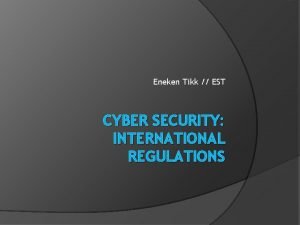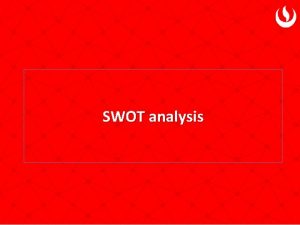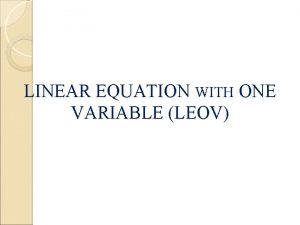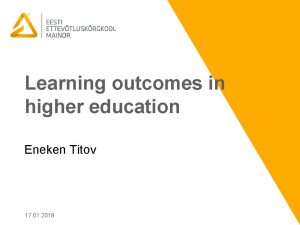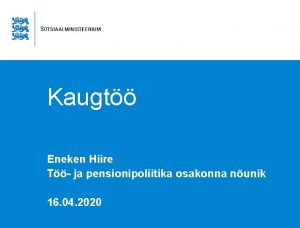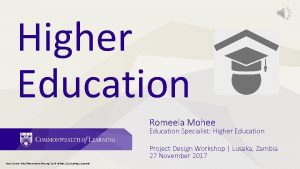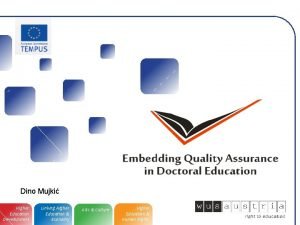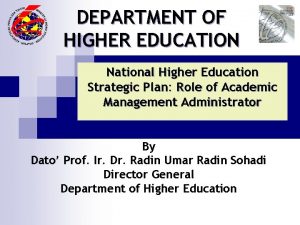Learning outcomes in higher education Eneken Titov 17













- Slides: 13

Learning outcomes in higher education Eneken Titov 17. 01. 2018

1. Focus on student 2. Understand the requirement 3. Formulate s the learning 4. Choose outcomes suitable topics and study 5. Formulate methods assignments and exercises 6. Create assessment 7. Formulate system the assessment 8. Control criteria and the exercises coherence within the 9. subject Apply on students: ) 10. Make improvemen ts

What is OBL (outcome-based learning)? 1. FOCUS ON STUDENT ‣ In the middle of the OBL is student and learning process – only according to them, we can build up the teaching strategy, topics and study methods. ‣ LOs have to be formulated according to the students needs to support them to meet requirements (HE in general, standards, employers expectations etc) ‣ LOs describe the competencies student can gain througout the studies. ‣ LOs are statements that specify what a learner will know or be able to do as a result of a learning activity. Outcomes are usually expressed as knowledge, skills or attitudes.

‣ Learning outcomes means statements regarding what a learner knows, understands and is able to do on completion of a learning process, which are defined in terms of knowledge, skills and responsibility and autonomy; ‣ Knowledge means the outcome of the assimilation of information through learning. Knowledge is the body of facts, principles, theories and practices that is related to a field of work or study. In the context of the EQF, knowledge is described as theoretical and/or factual; ‣ Skills means the ability to apply knowledge and use know-how to complete tasks and solve problems. In the context of the EQF, skills are described as cognitive (involving the use of logical, intuitive and creative thinking) or practical (involving manual dexterity and the use of methods, materials, tools and instruments); ‣ Responsibility and autonomy means the ability of the learner to apply knowledge and skills autonomously and with responsibility; ‣ Competence means the proven ability to use knowledge, skills and personal, social and/or methodological abilities, in work or study situations and in professional and personal development;

Exercise Which are the general requirements for your subject? Do you know? ‣ ‣. ‣. ‣.

Other requirements: 2. UNDERSTAND THE REQUIREMENTS ‣ Latvian state standards ‣ Occupational standards define the basic objectives and responsibilities appropriate for the occupation, basic requirements regarding professional qualification, the general and professional knowledge, skills, attitudes and competences necessary for performing them; ‣ European Qualification Framework and Latvian National Qualification Framework (level 6 is for professional bachelor) ‣ ‣ ‣ Advanced knowledge of a field of work or study, involving a critical understanding of theories and principles Advanced skills, demonstrating mastery and innovation, required to solve complex and unpredictable problems in a specialised field of work or study Manage complex technical or professional activities or projects, taking responsibility for decision-making in unpredictable work or study contexts; take responsibility for managing professional development of individuals and groups

General structure of the LO 3. FORMULATE THE LEARNING OUTCOMES 1) Students can/will be able to. . . 2) action verb. . . 3) specific action/skill they will be able to do (including discipline-specific knowledge, skill or ability).

Bloomi täpsustatud taksonoomia koos õpiverbidega (Biggs & Tang, 2009)

Exercise ‣ Which Bloom’s level those LOs indicate: ‣ Aware of and understand the main theoretical concepts of modern management ‣ Able to comprehensively grasp and understand the factors influencing the company's activity ‣ Able to correctly identify the company's existing management model ‣ Able to carry out basic analysis of the company's internal and external environment

Common mistakes in writing the LOs: ‣ Too many LOs ‣ LOs are too general on too detailed (eg. “knows letter A”, “knows letter B”, “knows letter C”. . or “can read”) ‣ Won’t cover the whole subject (eg. “Communication” and LOs are only describing listening skills) ‣ LOs are too complicated (eg. ‣ LOs are impossible to achieve ‣ LOs are not in the minimum level ‣ LOs are not outcome-based

Good LO: ‣ Is clear, concreat and simple, focuses for the most important aspect ‣ Is oriented for the student ‣ Includes of ONE verb (N: „nimetab organisatsiooni huvigrupid“) ‣ Is focused on the result (not process!) ‣ Determines the minimum level of results ‣ Together with other LOs describes the competence ‣ Is achievable ‣ Is possible to assess

Coherence within the subject ‣ LOs cover the whole subject ‣ Every topic is linked with the certain LO ‣ Every LO is assessed ‣ Every assessment criterion shows the achievement of the certain LO ‣ There is no parts in the subject which are not connected to the LOs

Thank you! Eneken@eek. ee
 Maxim titov
Maxim titov Eneken lüüs
Eneken lüüs Merje tikk
Merje tikk Outcome-based assessment in ecd
Outcome-based assessment in ecd Learning outcome examples
Learning outcome examples Water cycle learning outcomes
Water cycle learning outcomes Lesson plan on notice writing
Lesson plan on notice writing Learning outcomes of swot analysis
Learning outcomes of swot analysis Learning outcomes of rhymes
Learning outcomes of rhymes Planning goals and learning outcomes
Planning goals and learning outcomes Photolysis in photosynthesis
Photolysis in photosynthesis Objectives of photosynthesis
Objectives of photosynthesis Examples of student learning outcomes derived from ncbts
Examples of student learning outcomes derived from ncbts Objectives of linear equations in one variable
Objectives of linear equations in one variable


